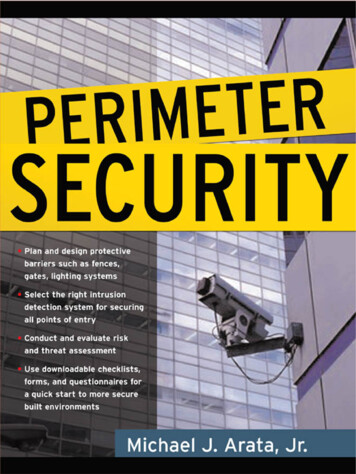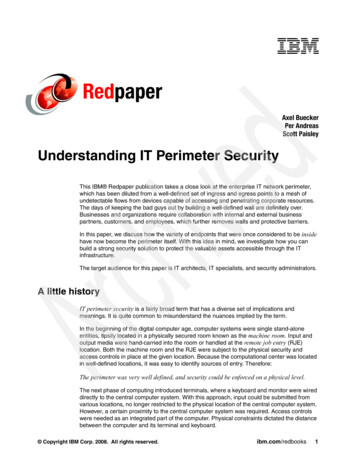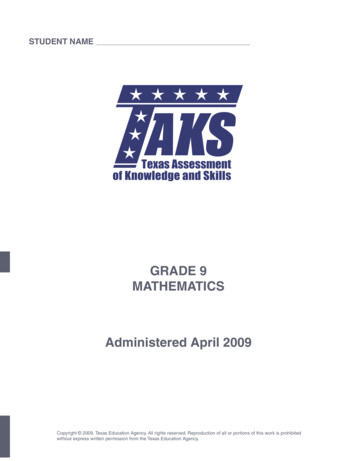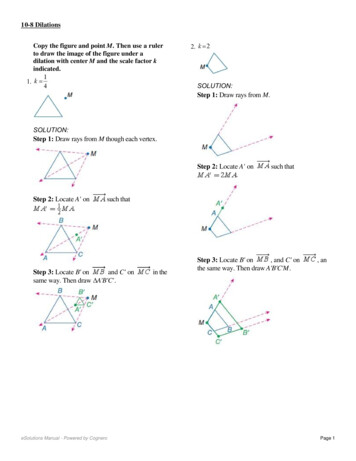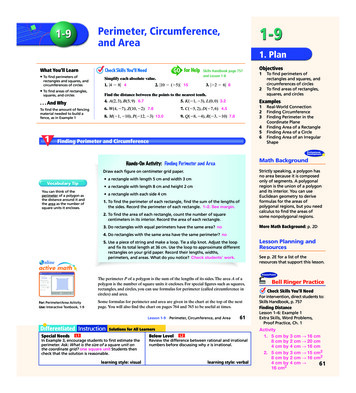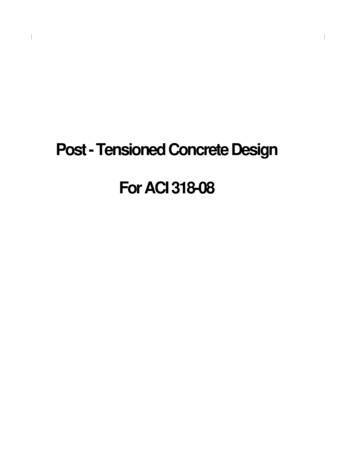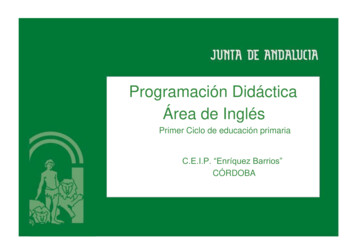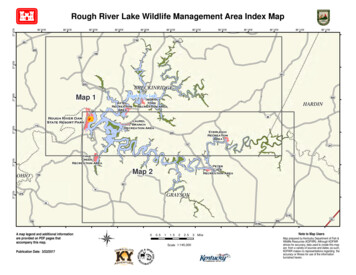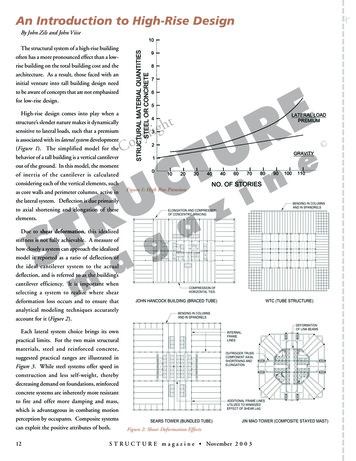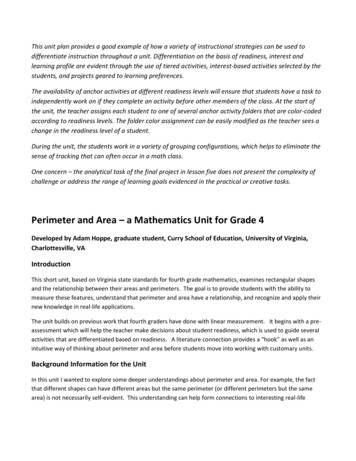
Transcription
This unit plan provides a good example of how a variety of instructional strategies can be used todifferentiate instruction throughout a unit. Differentiation on the basis of readiness, interest andlearning profile are evident through the use of tiered activities, interest-based activities selected by thestudents, and projects geared to learning preferences.The availability of anchor activities at different readiness levels will ensure that students have a task toindependently work on if they complete an activity before other members of the class. At the start ofthe unit, the teacher assigns each student to one of several anchor activity folders that are color-codedaccording to readiness levels. The folder color assignment can be easily modified as the teacher sees achange in the readiness level of a student.During the unit, the students work in a variety of grouping configurations, which helps to eliminate thesense of tracking that can often occur in a math class.One concern – the analytical task of the final project in lesson five does not present the complexity ofchallenge or address the range of learning goals evidenced in the practical or creative tasks.Perimeter and Area – a Mathematics Unit for Grade 4Developed by Adam Hoppe, graduate student, Curry School of Education, University of Virginia,Charlottesville, VAIntroductionThis short unit, based on Virginia state standards for fourth grade mathematics, examines rectangular shapesand the relationship between their areas and perimeters. The goal is to provide students with the ability tomeasure these features, understand that perimeter and area have a relationship, and recognize and apply theirnew knowledge in real-life applications.The unit builds on previous work that fourth graders have done with linear measurement. It begins with a preassessment which will help the teacher make decisions about student readiness, which is used to guide severalactivities that are differentiated based on readiness. A literature connection provides a “hook” as well as anintuitive way of thinking about perimeter and area before students move into working with customary units.Background Information for the UnitIn this unit I wanted to explore some deeper understandings about perimeter and area. For example, the factthat different shapes can have different areas but the same perimeter (or different perimeters but the samearea) is not necessarily self-evident. This understanding can help form connections to interesting real-life
applications of the mathematics, where an optimal solution can be sought (e.g. the least amount of fencing usedto surround an enclosure for a dog, etc.).In planning the unit, I looked at the state standards in mathematics for various grades and noticed that thismaterial is also taught in the second grade. However, it is unlikely that all students will have retained a perfectunderstanding of these concepts. Given that students will be at varying states of readiness related to priorknowledge and the measurement and multiplications skills needed for this unit, I knew I would have todifferentiate based on readiness. I also wanted to differentiate based on interest and learning style whenpossible because I wanted to provide choice, foster a sense of personal competency, and not least because Iwanted to keep the lines between high and low readiness students as blurred as possible.There is a tension in this unit between exploring the concepts and the limited time typically allocated for studyof these topics. At this point in the year (this unit is taught in the spring in my district), students will already befamiliar with many of the manipulative tools and classroom routines which support the learning activities – thisshould help students to get down to work quickly. Though student learning will eventually be assessed via theVirginia multiple-choice SOL test, this unit relies primarily on hands-on tasks. I believe that knowledge, skills andunderstandings developed in this way will be more enduring, and will transfer to paper-and-pencil tests.Mathematics Standards Addressed:Virginia Standards of Learning:4.134.11The student willa) identify and describe situations representing the use of perimeter and area; andb) use measuring devices to find perimeter in both standard and nonstandard units of measure.The student willa) estimate and measure length, using actual measuring devices, and describe the results in bothmetric and U.S. Customary units, including part of an inch (1/2, 1/4, and 1/8), inches, feet, yards,millimeters, centimeters, and meters;NCTM Standards:Instructional programs should enable all students to Measurement explore what happens to measurements of a two-dimensional shape such as its perimeter and areawhen the shape is changed in some way. develop strategies for estimating the perimeters, areas, and volumes of irregular shapes; select and apply appropriate standard units and tools to measure length, area develop, understand, and use formulas to find the area of rectangles and related triangles andparallelograms;
Geometry identify, compare, and analyze attributes of [two- dimensional] shapes and develop vocabulary todescribe the attributes; build and draw geometric objects; use geometric models to solve problems in other areas of mathematics, such as number andmeasurement; recognize geometric ideas and relationships and apply them to other disciplines and to problems thatarise in the classroom or in everyday life.Unit ObjectivesAs a result of the unit, the students will know Perimeter is the distance around a closed figurePerimeter is measured with units of length, including metric units and US customary units (inches,centimeters, yards, meters)Perimeter of a figure can be found by adding the lengths of the sidesArea is the size of a two dimensional object; it is the (two dimensional) space inside a regionArea is measured by units of area, including metric and US customary units (square inches, yards,centimeters, meters)The area of a rectangle can be found by multiplying length by widthAs a result of the unit, the students will understand that Perimeter and area are important concepts in daily life as they are widely applied by builders, architects,painters, farmers/gardeners and other designersThere is a relationship between the perimeter and shape of a rectangle and its areao Rectangles of a given perimeter don’t necessarily have the same areao Rectangles of different shapes can have different areas but the same perimetero The perimeter of a rectangle of a given area can be maximized; the area of a rectangle of a givenperimeter can be maximizedAs a result of the unit, the students will be able to Select appropriate tools and units to measure perimeter and area of both physical objects andrepresentationsLabel rectangles with measurements of perimeter and areaIdentify and describe real-life situations in which area and perimeter are usefully appliedCommunicate effectively through drawings, words and numbersWork cooperatively in a small group
Instructional Strategies Used BrainstormingTiered questioningTiered assignmentsSternberg’s Tri-mind learning preferencesInterest-based assignmentsFlexible groupingSmall group and pair collaborationCooperative problem solvingLearning ContractsAnchor activitiesUnit Pre-assessment OverviewBefore beginning the unit, students will complete two pre-assessment tasks. The first is a writing prompt intheir math journals, to draw a picture of perimeter and a picture of area, explaining both in words. At this pointin the year, students will have much practice in using drawings and words to explain their mathematicalthinking. The drawings and explanations can be examined for evidence of connections to the goals ofinstruction. Do the students know what the terms (which are also studied in the second grade in VA) mean? Dothey use principles of measurement and units in their drawings? Do they show signs of connecting the conceptsof area and perimeter? A 3-2-1 exit card at the end of the first lesson will also provide pre-assessment data.The students’ drawings of three table configurations will show their comfort with representing area andperimeter, and the question about making another way of seating 32 guests will gauge whether or not studentsare capable of self-extending what they know about perimeter and area at this point.In addition to this data, at this time in the year the students’ skills with multiplication, which are related toseveral of the tasks, will already be known. All this data on student readiness can be used to determine thecomplexity of tasks to be given to each student in the next lessons. Students who show higher levels of existingachievement can be given the more difficult tasks, while students with little memory or understanding of theconcepts will be given less complex tasks to begin with.Sample Differentiated Materials Provided Lesson 1 – Readiness-based tiered questioning scriptLesson 2 – Readiness-based tiered cooperative problemLesson 3 – Readiness-based learning contractsLesson 4 – Interest-based application taskLesson 5 – Learning profile-based final task
Unit OverviewLessonLesson 1:Introduction & LiteratureConnection1 class periodLesson 2:Area and Perimeter using aproblem-based approach1 class periodLesson 3:Learning Contracts2 class periodsWhole-class componentsDifferentiated componentsWriting activity as pre-assessment (10minutes)Read-aloud and diagramming of Spaghettiand Meatballs for All! (35 minutes)3-2-1 Exit Card (10 minutes)Introduction of tangrams as anchor activity(5 minutes)Tiered Questioning scriptTangrams can be tiered for readinessTiered tasks based on readiness (35minutes)Whole-group sharing for lesson closure (10minutes)Discussion of definitions and tools formeasurement with whole-groupbrainstorming session of things that havearea and perimeter (10-15 minutes)Learning Contract Tasks (90 minutes)Whole-group brainstorming session aboutuses of area and perimeter in daily life (5-10minutes)Lesson 4:Interest-based application andpractice1 class periodLesson 5:Unit assessment1-2 class periodsSelf-selected application tasks basedon interests (45 minutes)Whole-class sharing of results (5-10 minutes)Self-selected final products based onSternberg’s tri-mind learning profiles(1-2 class periods, including time toshare products)
Unit Description and Teacher CommentaryLESSON 1 – SPAGHETTI AND MEATBALLS FOR ALL1 CLASS PERIODLesson Sequence and DescriptionTeacher CommentaryPre-assessment: Ask the students to write in their math journals: Draw apicture of “perimeter.” Explain your picture in words. Draw a picture of“area.” Explain your picture in words. These prompts can be projected forstudents to work with directly in their math journals. Circulate among thestudents as they work to informally assess their readiness levels inpreparation for tiering questions during the read-aloud. Alternatively, givethis pre-assessment any time before this unit begins.Literature Connection: Spaghetti and Meatballs for All! By Marilyn Burns:Read the story aloud to the students (whole group). Have an overhead orother technology available and draw the different scenarios of chairs andtables as presented in the book. You will model this activity while usingTiered Questioning (see differentiated materials appendix) during thepauses to examine what’s happening. The tiered questions are divided intothree levels. The first level of questions is less complex and more concrete –the questions can be answered by looking at the figures and counting tablesand chairs. The middle tier moves into using the abstract terms ‘perimeter’and ‘area’ instead of asking students to count tables or chairs, and is alsomore difficult in requiring some comparisons to be made. The highest tier ofquestions is yet more complex and open-ended, asking students to reasonout general rules for the scenario and apply those rules in predictions.3-2-1 Exit card: Have students work on the following prompt and drop offtheir exit cards in the designated location.Draw 3 different ways the tables were set up in the book. Include the chairs.Write the perimeter and area of each table you draw.Write 2 two things you liked or didn’t like about the book.Draw 1 other way you could seat 32 guests. You can use as many tables asyou want but the same rules about elbow-room apply!At this point in the year students are mostlycomfortable combining writing with drawingsand numbers to explain their thinking.A literature connection typically necessitatesa whole-group setting. In order to allow allstudents to participate in this setting and tocontinue to experience success, thequestioning is pre-written and tiered forachievement level. Students will be matchedwith appropriate questions.A 3-2-1 exit card allows a check-in aboutstudent ability to represent perimeter andarea using the chairs/tables method. Thesecond question gathers feedback to informthe next teaching of this unit. The lastquestion requires extension and is similar tothe next day’s task, providing assessmentinformation for grouping students in lesson 2.
LESSON 2 – TABLES AND CHAIRS PERIMETER TASK, MATHJOURNALSLesson Sequence and DescriptionIntroduce the tangrams anchor-activity: Show the students how thetangram shapes can be cut out of a single square. Introduce the tangramsworksheets, which have students create shapes from the tangram piecesand compare their sizes. Show students the folders holding the activities(located in an accessible part of the classroom)Math Journal Problem: Students will work with Tiered math journalactivities(see differentiated materials appendix), using scenarios based onthe tables/chairs problem used in the book from the previous lesson.Students are divided into three groups based on readiness shown in the preassessment and exit cards. When working on math journal problems,students know that they may work with a partner, but are responsible fortheir own recording. The problems are essentially similar, so the task can beintroduced to the whole group, and students then work with more- or lessscaffolded journal pages. Materials such as manipulatives and graph paperwill be available for use. The problems are tiered based primarily oncomplexity and open-endedness. The lower tier is fairly directive, studentsfollow the steps as directed and discuss their conclusions. The middle tiertask is somewhat more open-ended. It requires students to choose theirtables and chairs scenarios themselves and make more open-endedcomparisons. The highest tier task pushes students into more abstract,open-ended territory by asking them to seek out optimal solutions to theproblem, which may also require more drawings and more calculations(which might bog down less-ready students), depending on the approachtaken.Display color-coded (readiness) groups on the board, and tell the studentsthat they may work with a partner from their own color group. Have thestudents pick up the journal sheets from color-coded folders and beginworking.Whole class review: Students can share their solution paths for this problemin a whole group setting. Together, the class will likely produce the wholerange of possible solutions for this problem. Document the shapes of thetables created on the board and help the whole class generalize aconclusion: which shapes have the most area (given the same perimeter?)1 CLASS PERIODTeacher CommentaryTangrams are a fun way to work with theconcept that area is a way to compare sizes ofobjects. This anchor activity would bedifferentiated for readiness by havingcolored-coded folders with more or lessdifficult tangram patterns to copy.The tiered journal problems help scaffoldthose who lack skills with measurement orusing manipulatives, while posing aninteresting challenge for middle and highreadiness students.It is helpful for students to hear their peersexplain their solution paths. Since studentshave worked on the same essential task,everyone can contribute to the groupdiscussion. Start with lower-readinessstudents since they didn’t have a choice ofwhich tables to make.
LESSON 3 – LEARNING CONTACT SKILLS PRACTICE2 CLASS PERIODSLesson Sequence and DescriptionTeacher CommentaryReview of definitions: Present definitions of length, width, perimeter, andarea and display examples of each, along with tools used to measure them(rulers and transparent area measurement grids). Refer to environmentalprint (math posters) with these definitions as well. Brainstorm a list ofobjects in the room that have perimeter and area.Area and perimeter are taught in secondgrade, so this review is brief and serves tohelp everyone have the vocabulary to workwith the story coming up. Also, it makesconnections to the real world.Learning Contracts: Introduce the learning contracts and orient studentstowards the materials they will need. Each student will have a customlearning contract based on needs and readiness (see Learning ContractActivities and Example in the differentiated materials appendix).The tasks range from comparisons of paper cut-outs which will help studentgrasp the fundamental concept that area is the size of an object, to morecomplex tasks based on examining area and perimeters when one or theother attribute is fixed.Learning contracts allow each student toexperience multiple activities for theirparticular needs and readiness. They alsoallow the teacher to conduct small-groupinstruction while other students workproductively, and provide choice andindependence to students.Whole-group brainstorming session about uses of area and perimeter indaily life: Lead a whole-group brainstorming session to come up with waysthat professionals use calculations of perimeter and area in their jobs ordaily lives. This is also the time to introduce the choices for the interestbased task tomorrow. Have students put their top two choices on an exitcard and drop it off in the usual location.Having worked with chairs-and-tablesscenarios and measured objects around theroom, students have exposure to how areaand perimeter work in the real world, and canmake connections to broader applications ofthe concepts.
LESSON 4 – APPLICATION TASKS1 CLASS PERIODLesson Sequence and DescriptionTeacher CommentarySelf-selected tasks based on interest: Introduce the tasks for today, whichare designed to tap into student interest while providing a real-worldapplication of the uses of area and perimeter. These Interest-basedexplorations (see differentiated materials appendix) give students achoice in activities and experience working with a mixed-readiness group.Students have chosen whether to complete the sports facility, school redecorating, or garden design task. Display the group assignments (of 3-4mixed-readiness students) on the board, along with the work-spaceassignments. Have students pick up sets of materials based on their task,plus their order form to buy other needed materials from the store, andassign them to a work space in the room.Interest-based groups help students to notfeel invalidated by too much readiness-basedgrouping. Having the students fill out theirorder forms completely before coming to theteacher-operated store provides plenty oftime to circulate among the groups to assist.The first task will hopefully be of interest tostudents interested in school and/ordecorating, the second to students interestedin sports, and the last to students interestedin gardening or farming.As they work, each group can use a system of stacked cups (red, yellow, andgreen) to signal if they need teacher assistance. A green cup on top of thestack indicates that all is well, yellow means a group has a question but canstill make progress, and red indicates that the group is stuck and needsteacher assistance to move forward at all. Circulate throughout the room asstudents work, and distribute materials from the “store” when studentshave completed order forms.Whole-group sharing: Students will share the products of their group tasks.This will allow for a discussion of different ways to approach the problems,which are fundamentally similar. Also discuss what went well while workingin groups as an opportunity to reflect on and improve group workeffectiveness.One interesting question to ask here iswhether the students bought any extramaterials (or too little material). If so, youcould ask why this might have been and see ifstudents are having difficulty withmeasurement or perhaps calculation ofperimeter and area.LESSON 5 – UNIT ASSESSMENT PROJECTS1-2 CLASS PERIODSLesson Sequence and DescriptionTeacher CommentarySelf-selected assessment tasks based on learning profiles:These tasks ask students to demonstrate their knowledge, skills, andunderstandings within the context of a learning format appropriate to theirown style (see Learning Profile Final Projects in the differentiatedmaterials appendix). The first task is designed for students who arecomfortable thinking in a practical mode. The second is for students whoprefer creative thinking, and the last is designed for analytical thinkers.Describe the tasks to the students and allow them to choose a task to theirliking.The creative task is more open ended;although the task describes conditions forsuccess, careful monitoring of studentsworking on a creative task is called for.
DIFFERENTIATED MATERIALS APPENDIXDIFFERENTIATED MATERIALS – LESSON 1: Tiered Questioning ScriptThis script is for a point in the book where 12 guests are trying to seat themselves together at the same table.Before this point, six guests were seated around two tables (as in Figure 1). The guests add two more tables,thinking that this will allow six more people to sit (see Figure 2). The next step in the book is Figure 3 – theguests add an additional 2 tables, still trying to seat 12. These questions examine the change from figure one tofigure two, and anticipate the change to figure 3.Low-readiness:How many tables are together now? How many tables were added?How many chairs were there before? How many chairs fit around the table now?How many seats did they gain? Do they have enough seats? How many more seats do they still need?Middle-readiness:What is the perimeter of this table?How does the perimeter of this table compare to the perimeter of the previous table?What is the area of this table?How does the area of this table compare to the area of the previous table?How many people can sit at each table now? How does this compare with the previous table?Higher-readiness:Why didn’t adding two more tables make it so six more people could sit at the table?Would it help if they had added the tables to the ends, making a long line instead of a square? Why or why not?Will adding two more tables (for a total of six tables) solve their problem? Why (or why not)?Is there any way to add tables and gain more than two seats (while still keeping the shape a rectangle)? Explain.Fig. 1Fig. 3Fig. 2
DIFFERENTIATED MATERIALS – LESSON 2: Tiered Party Planning Math Journal TaskThese materials are tiered for readiness. The more difficult task provides much less support for students as theymust find optimal solutions to the problem. The task designed for middle-readiness students reduces thedemand by not requiring optimal solutions, but still requires students to think of multiple routes to the samegoal of 24 chairs around the table. The task designed for the least-ready students provides additional supportsby directing students towards two possible solutions. The students are still responsible for creating thesolutions themselves. All students do similar actions – measuring area and perimeter - and they all ultimatelywork with the same understanding – the relationship between area and perimeter.Task for Highest-Readiness Group:You are hosting a picnic at Washington Park. Unlike Mrs. Comfort (from Spaghetti and Meatballs for All!), youknow that all your guests want to sit at the same table. Like Mrs. Comfort, you have to rent small square tablesto use. Each table costs 10 to rent (the chairs are free). You have three tasks.1. Find the least expensive way to seat all 24 guests. Use pictures, numbers and words to prove you’reright. Make sure you draw a picture of your table and label the sides, perimeter and area.2. Next, find the most expensive way to seat all 24 guests without having any extra chairs. Use pictures,numbers and words to prove you’re right. Make sure you draw a picture of your table and label thesides, perimeter and area.3. Once you find both, answer these questions on this paper:a. How do the perimeters of each table compare?b. How do the areas of each table compare?c. How does the shape of the table affect the price?
Task for Middle-Readiness Group:You are hosting a picnic at Washington Park. Unlike Mrs. Comfort (from Spaghetti and Meatballs for All!), youknow that all your guests want to sit at the same table. Like Mrs. Comfort, you have to rent small square tablesto use. Each table costs 10 to rent (the chairs are free). You have three tasks.1. Draw at least three different ways to seat all 24 guests at the same table with no extra chairs. Usepictures, numbers and words to prove your tables will seat 24 people (no less, no more). Make sure youdraw a picture of your table and label the sides, perimeter and area.2. For each table, calculate how much you will have to pay to rent the tables you will need:Table 1: Table 2:Table 3:3. Answer these questions:a. Compare the perimeter of your most expensive table and your least expensive tableb. Compare the area of your most expensive table and your least expensive tablec. Compare the shapes of your most expensive table and your least expensive table
Task for Lower-Readiness Group:You are hosting a picnic at Washington Park. Unlike Mrs. Comfort (from Spaghetti and Meatballs for All!), youknow that all your friends want to sit at the same table. Like Mrs. Comfort, you have to rent small square tablesto use.1.Use 20 square tiles to make a table that will seat your 24 friends (with no extra seats). Use all of thetiles. Draw your table here:The perimeter of this table is:The area of this table is:2. Use 32 tiles to make another table that will seat your 24 friends (with no extra seats). Use all of the tiles.Draw your table here:The perimeter of this table is:The area of this table is:3.Answer these questions:a. Each table costs 10 to rent. Which table will cost more to rent? How do you know?b. Describe the shape of the more expensive table.c. Describe the shape of the less expensive table.
DIFFERENTIATED MATERIALS – LESSON 3: Learning Contract ActivitiesThe activities presents below can be arranged into learning contracts tailored to individual needs. Each activityhas a brief description along with a suggestion for each task’s use with students of different readiness. At thispoint in the unit, assessment data will be available to guide the choice of activities, though all students will needto complete at least some measurement activities to ensure the standards are addressed. A sample learningcontract for a middle-readiness student follows the activity descriptions.MEASUREMENT:1. Measurement of rectangular shapesDescription: Students use rulers and transparent area grids to measure pre-cut cardboard rectangles andrectangles printed on paper, recording area and perimeterReadiness suggestions: Lower-readiness students mostly use rectangles smaller than their measuring tools, anduse the pre-cut rectangles. Higher-readiness students measure rectangles larger than their measuring tools andmeasure rectangles printed on paper2. Measuring around the roomDescription: Students use rulers and transparent area grids to measure physical objects and record area andperimeter.Readiness suggestions: Lower-readiness students mostly measure objects smaller than their measuring tools,higher-readiness students measure mostly items larger than their measuring tools.COMPARISONS:1. Two-piece shapes*Description: Students fold and cut 6 index cards to make two identical triangles. They rearrange the trianglesinto different shapes with the rule that only sides of the same lengths can be matched up and must be matchedexactly. Students record the shapes they made and answer questions about the area of the shapes (which isidentical for each shape)Readiness suggestions: Use with lower-readiness students2. Rectangle Compare with no units*Description: Students work with pairs of rectangles which are blank except for labels. Pair A: 2x9 and 3x6rectangle. Pair B: 1x10 and 3x5 rectangle. Pair C: 3x8 and 4x5 rectangle. They determine which rectangle hasgreater area or if they are the same size. They may cut for fold the rectangles. They will draw their solution andexplain their decision.Readiness suggestions: Use Pairs A and B with lower-readiness students. Use pairs B and C with middlereadiness students (pair C is harder to compare directly)3. Rectangle Comparison with square units*Description: Students work with printed pairs of rectangles which are the same or very similar in size. (e.g.:4x10 and 5x8, 4x6 and 5x5) They use a model or drawing of a square unit, along with a ruler, to determine which
rectangle is larger. They cannot cut out the rectangles but may draw. They will explain their conclusion inwords, drawings, and numbersReadiness suggestions: Students with lower achievement in multiplication can use smaller rectangles to removesome of the burden of calculation.4. Fill and Compare*Description: Students work with two rectangles and a blob shape, all similar in size, drawn on a sheet of paper.Students first guess which shape is larger, record their guess, then use a filler (color tiles) to fill in their shapeand verify their guess.Readiness suggestions: Students with lower achievement in multiplication can use smaller rectangles to removesome of the burden of calculation.EXPLORATIONS & CLARIFICATIONS:1. Fixed perimeters*Descript
minutes) Read-aloud and diagramming of Spaghetti and Meatballs for All! (35 minutes) 3-2-1 Exit Card (10 minutes) Tiered Questioning script Lesson 2: Area and Perimeter using a problem-based approach 1 class period Introduction of tangrams as anchor activity (5 minutes) Whole-group
